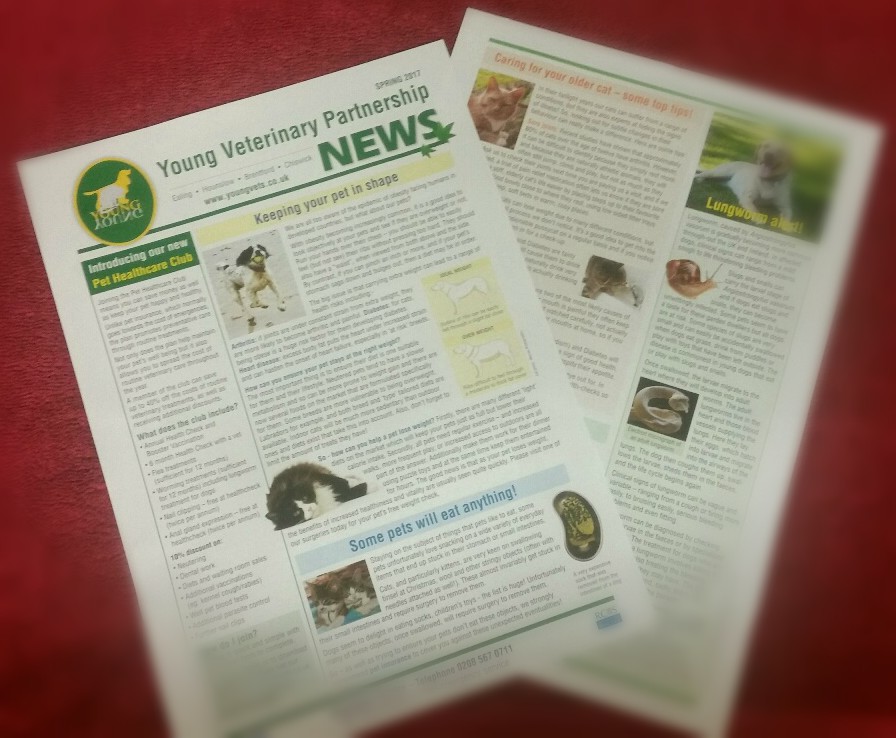Included in our spring newsletter: Keeping your pet in shape, what happens when your pet becomes overweight, rabbits teeth – a growing issue and caring for your older cat, some top tips. Read our Spring 2017 newsletter here.


Included in our spring newsletter: Keeping your pet in shape, what happens when your pet becomes overweight, rabbits teeth – a growing issue and caring for your older cat, some top tips. Read our Spring 2017 newsletter here.

More than 80% of owners say their pet is afraid of firework noises. Signs of stress in dogs include trembling, shaking, hiding behind furniture, barking excessively, and trying to run away. Cats are much better at hiding their anxiety, but symptoms may include excessive meowing, refusal to eat, hiding, or vertical scratching and spraying.
Often mild reactions to fireworks can be managed with a pheromone (scent) spray; called Feliway in cats and Adaptil in dogs. These products can be purchased from our surgeries.
More severe reactions in dogs may be managed with a combination of sound desensitisation, using CD’s such as Soundsscary, and Adaptil. Occasionally tranquilizers may be prescribed after consultation with your vet, but these are generally used as a last resort.
Further tips for reducing firework anxiety include:
i. Provide a den or hiding place; this works best if it is a place previously chosen by your pet when they have been frightened before.
ii. Plug a Feliway diffuser or Adaptil diffuser close to the den at least a few days before the fireworks start.
iii. Try to ignore behaviour such as whining and crying, panting or pacing. Pets can pick up on their owner’s anxiety, and if you try to soothe them it can reinforce the belief that fireworks are something to be afraid of. It is also important not to scold them.
iv. Close doors and windows, close curtains and turn on music or the TV to mask some of the noises.
v. Keep cats indoors and have them microchipped in case they escape.
Please contact any of our surgeries in West London for further information or a consultation. Please see www.youngvets.co.uk for contact details.

Tick borne diseases:

 New research published in the Veterinary Record has proved the importance of seeing your pups’ parents when choosing a puppy.
New research published in the Veterinary Record has proved the importance of seeing your pups’ parents when choosing a puppy.
Owners who had seen neither parent are 4 times as likely to need to take their dog to see an animal behaviourist. Owners who had seen just one parent (usually the mother) are 2.5 times as likely to have behavioural problems with their dog than owners who had seen both owners.
Seeing the mother allows you to assess the mother’s temperament, its condition and the puppies rearing environment. Ideally your puppy should not be separated from its mother until 8 weeks of age, which also reduces the chances of future behaviour problems. We recommend an eight week health check up with your vet, when the first vaccination can be administered. See www.youngvets.co.uk for contact details of your nearest surgery in Ealing, Brentford, Chiswick or Hounslow.

Many people will decide to let their bitch have a single litter of pups. Most bitches will have a healthy litter of pups without needing any medical intervention. The following is some pointers about the processes involved, and an indication of what is normal.
The mother should be up to date with vaccinations before she is mated. Bitches ovulate around 12 days after the onset of the season, and will normally stand to be mated once the blood spotting has stopped. Two matings 2 days apart at this time are ideal. Once pregnant a monthly treatment with a spot on wormer (Stronghold) will reduce transmission of any worms to the puppies.
The normal gestation period is 63 days (9 weeks), but the time from mating to giving birth can be 63 days +/- 1 week. Providing a warm bed in a quiet and draft free region of the house is a good idea. The mothers rectal temperature will normally drop 1-2 degrees C within 24 hours of giving birth. Once second stage labour has started, and the mother starts strong contractions, a puppy should be produced with 30 minutes. Veterinary attention should be sought if strong contractions have been seen for more than 30 minutes, or if weak straining has been seen for more than 4 hours, or if fetal fluids were seen more than 3 hours without a puppy being produced. Puppies can be produced at intervals ranging from 5 minute to 2 hours. The mother should break the umbilical cord instinctively and lick the puppy clean which stimulates the puppy to breath. If the mother is not doing this then the face should be cleaned of fetal membranes with a towel , and then the towel is used to rub the puppy gently but briskly for 30 seconds, to dry them off and stimulate breathing.
The temperature in the puppy area should be kept warm – around 30 C at birth. Infra-red lamps can be ideal to provide this heat.
Puppies normally feed every 2-3 hours for the first few days after birth. The first milk produced in the first 24 hours is called colostrum, and boosts the immune system. Thus is is very important that all puppies suckle this early milk. They should gain 5-10% of their body weight each day and should weigh double their birth weight by day 10-12.
They should be lifting their heads by 3 days and crawling by 7 days but are usually unable to stand until the end of the third week. They will spend 80% of their time sleeping. Body temperature is lower (35-37C) in new born puppies than an adult dog. The normal breathing is 10 to 20 breaths per minute at birth, increasing to 15-40 breaths per minute by 7 days old. (the smaller the breed the higher the rate).
The puppies eyes are closed at birth and normally open at 2 weeks, and the ears are also closed at birth and open at 14-16 days. There is normally no discharge from the eyes or nose.
Worming can be started from 3-4 weeks of age, and repeated every 2 weeks with panacur. Solid foods can be started from 3 -4 weeks of age by mixing a good quality complete puppy food with some powdered formula bitch milk ( lactol), four times daily.
See www.youngvets.co.uk for contact details for your nearest vet surgery in west london.